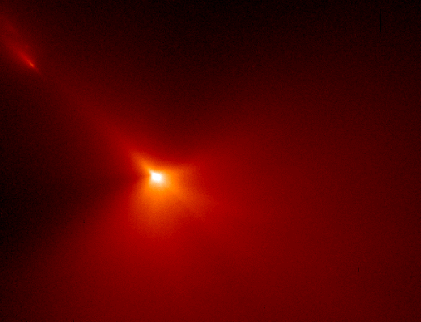Explanation: NASA's Hubble Space Telescope captured this image of the near-nuclear region of Comet Hyakutake on March 25 as the comet approached within 9.3 million miles of the Earth. It covers a relatively "small" 2,000 mile wide area with the sunward direction toward the lower right (tailward is upper left). The image shows large amounts of dust jetting from the sunward side of the nucleus as the sun heats the surface of this dirty "orbiting iceberg". Pressure from sunlight eventually pushes the dust tailward and as the dust production increases, the already visually impressive tail will grow even brighter! The actual size of the nucleus is uncertain but is estimated to be 5-10 miles, similar to Comet Halley. As seen here, the brightest point is probably the tip of the strongest dust jet rather than the nucleus itself. A dramatic dust jet feature also appears to arise from the nightside but its true angle to our line of sight is difficult to judge. Some large fragments which have broken away from the comet nucleus are visible in the upper left of the image, producing dust tails of their own. Comet dust may represent primordial material from the formation of the solar system and NASA has plans for a comet dust sample return mission.
Latest Comet Hyakutake images:
JPL,
Crni Vrh Observatory,
Slovenia,
Fayetteville
Observer-Times,
NASA's Night of
the Comet
1999 2000 2001 2002 2003 2004 2005 2006 2007 2008 2009 2010 2011 2012 2013 2014 2015 2016 2017 2018 2019 2020 2021 2022 2023 2024 2025 |
Yanvar' Fevral' Mart Aprel' Mai Iyun' Iyul' Avgust Sentyabr' Oktyabr' Noyabr' Dekabr' |
NASA Web Site Statements, Warnings, and Disclaimers
NASA Official: Jay Norris. Specific rights apply.
A service of: LHEA at NASA / GSFC
& Michigan Tech. U.
|
Publikacii s klyuchevymi slovami:
nucleus - kometa Hiyakutake - kometnye hvosty - komety - yadro komety
Publikacii so slovami: nucleus - kometa Hiyakutake - kometnye hvosty - komety - yadro komety | |
Sm. takzhe:
Vse publikacii na tu zhe temu >> | |
